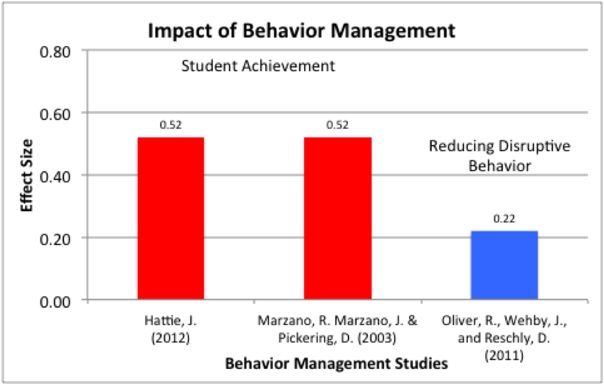Nowadays, teachers jobs becoming more difficult because many students show unexpected behaviour most of the time in the classroom, which is not appropriate at that particular time. Every teacher must know different strategies for behaviour management of the whole class which can benefit both teachers and students to fulfill their roles in the class successfully.
According to winginstitute.org, if teachers implement behaviour management strategies, then it creates a positive impact on the classroom and reduces the disruptive behaviour of students at the same time.

Source: winginstitute.org
If a teacher wants to create a productive and disciplined classroom environment then the best way to achieve this is to teach about expected and unexpected behaviour to students. In this blog post, we will be sharing five effective ways to teach expected and unexpected behaviour to students.
Before moving to the topic, can we ask you a question? Do you follow us on Social Media? We regularly share upgraded educational content, tips, feedback, and more. Check us out by clicking the profiles here - Facebook / Twitter / LinkedIn / Pinterest / Instagram / YouTube
So, without any further delay, let’s get started.
Step 1: Give Clear Idea of Expected vs Unexpected Behaviours
The very first step of teaching any important topic like expected vs unexpected behaviour is to give them a clear idea about it. You can use simple language and real-life examples so that every student can relate to and by doing this you reduce the chances of any confusion for the students so that they can be on the same page.
Additionally, try to be a more empathetic teacher and you can become one by using “good” or “poor” instead of the term bad which can lead to negative perception. Furthermore, you can be more culturally aware teacher by knowing that in some culture direct eye contact can be seen as a sign of disrespect so you can be aware of this kind of cultural facts to adjust your expectations accordingly.
Lastly, ensure that your expectations are specific and observable. Students should be able to differentiate between correct and incorrect behaviours and have a clear understanding of what expected and unexpected behaviours physically look like. This will help them easily portray all that they desire.
Step 2: Make Them Understand the Importance of Expected and Unexpected Behaviour
Once you have clearly defined the difference between both expected and unexpected behaviours, it is important to focus on the need to follow such expectations. Students are more likely to follow these expectations when they understand why they were made. Involving students in establishing the expectations can be one way of achieving this.
For example, students can come up with a specific phrase or hand signal to use if the expectation is to ask for permission before leaving the classroom. By involving students in this decision-making process, there is a sense of ownership and engagement.
Step 3: Direct Instruction with Expected vs Unexpected Behaviours Lesson
Direct instruction is an effective method for teaching expected vs unexpected behaviours. Start by making expectations clear and you can draw the comparison with the unexpected behaviours. This will help the students to understand the meaning of the concepts in terms of right versus wrong.
Provide several examples that show how far apart expected and unexpected behaviour are. To begin with, you can give a few examples yourself so that the students can come up with their own.
For example, when someone has an item or tools they are using, an expected behaviour would be asking if you could use it once they are finished. On the other hand, when one takes something without permission or makes a scene by crying and flopping on the ground that’s totally not appropriate behaviour. By providing real-life examples, students will be able to comprehend the concept better as well they can apply it to their own lives.
Step 4: Practice with Expected vs Unexpected Behaviours Activities
Practice is key to reinforcing the understanding of expected and unexpected behaviours. Engage students in various activities that allow them to apply their knowledge and skills. Here are some engaging ideas:
- Situational Practice: Expected Vs Unexpected Behaviours Scenarios
Give different situations to students and let them tell whether the given behaviour is expected or unexpected. Alternatively, you can guide them to choose the correct choice of action in each scenario. To further enhance the engagement rate of students, you can encourage students to act out the situations in pairs or small groups. You can also leverage digital platforms like Boom Learning or Kahoot to create interactive digital task cards or assessments.
- Worksheet Practice: Expected Vs Unexpected Behaviours
Worksheets are great ways of reinforcing the teaching of expected and unexpected behaviours. You can provide worksheets with real-life conditions where they will have to identify whether their behaviour was expected or not. In order for this goal to be achieved, scenarios need to be discussed in detail for better understanding to be created through rich conversations. Free printable worksheets can also be used, alternatively, a well- structured worksheet pack can be bought containing various aspects of expected and unexpected behaviours.
- Learning with Read Aloud Method
You can incorporate read-aloud method in your teaching in order to make it more engaging and interactive. Selecting books that teach about following expectations, and then discussing them with students. You can also highlight specific rules or expectations from the book that align with your classroom expectations. Some of the recommended books include “What If Everybody Did That?” by Ellen Javernick, “What Should Danny Do? School Day” by Adir Levy, and “David Goes to School” by David Shannon. Reading aloud books like this as a class all together can give a clear idea of expected and unexpected behaviour to students.
- Expected Vs Unexpected Behaviours Game
You can create games around expected vs unexpected behaviours to make learning more enjoyable for students. You can create a game board or you can use an existing one such as, Candy Land. You can also design playing cards with various situations involving either expected or unexpected behaviours. As the students move around the game board, they can answer card situation by identifying whether the behaviour is expected or not expected. For non-readers or struggling readers like children with special needs, you can use real-life picture cards to facilitate comprehension. Ready-made games focusing on a detective theme can save time and effectively engage learners instead.
Step 5: Regular Reinforcement of Expectations Behaviours
Lastly, consistent reinforcement is crucial to ensure that students continue to exhibit expected behaviours. Acknowledge and reinforce behaviours that align with expectations to encourage students to maintain those behaviours. This can be as simple as providing verbal praise, such as saying "good job" or "I like how you are following the expectations." You can also incorporate tangible rewards into your existing reward system in the classroom. Sending notes home to parents, highlighting specific positive behaviours, can also be effective in reinforcing expected behaviours.
Remember to make the reinforcement specific and meaningful. By highlighting the specific behaviours that students are exhibiting, you encourage them to continue doing so. Regularly reinforcing displayed behaviour helps to create a positive classroom culture and motivates students to meet behaviour expectations consistently.
Teaching about Expected and Unexpected Behaviour Can be a Game Changer
Teaching is one of the noblest professions but at the same time, it has its own challenges as well, especially when students are showing unexpected behaviour in the classroom. However, those teachers who have pursued courses like Diploma in Counselling course for teachers, have a better understanding of every student’s psychology and they know why teaching about expected and unexpected behaviour to students is necessary to create a positive and disciplined learning environment in the classroom.
Furthermore, we also have shared multiple strategies for teaching about expected and unexpected behaviour to students with which you can achieve a classroom culture where students consistently exhibit expected behaviours, leading to a more enjoyable and productive learning experience.
We believe education should be accessible for everyone. That’s why we don’t charge for our blogs. Find the right course that will help you in your career with us, contact us at - + 1800–212–6400. You can mail us at act@asiancollegeofteachers.com.
Written By : Abhishek















